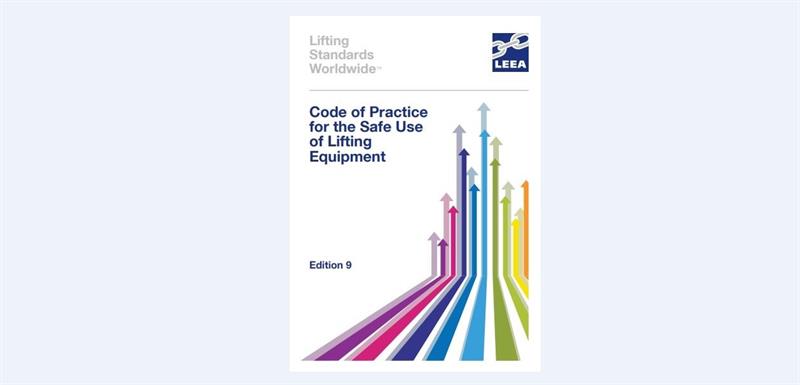The Lifting Equipment Engineers Association published the ninth edition of its guide to lifting safety last year. Who is it aimed at and what has changed?

The Lifting Equipment Engineers Association (LEEA) is a trade association that aims to promote enhanced standards and sustainable development for the worldwide lifting and safety industry. With this in mind, it published the ninth edition of its ‘Code of Practice for the Safe Use of Lifting Equipment (COPSULE)’ in November.
Commenting on the launch, LEEA CEO Ross Moloney said: “LEEA strives to promote enhanced standards for the worldwide lifting industry. By making our code of practice freely available, we hope that more end users will be able to access it so that eventually best practice becomes normal practice.”
LEEA's COPSULE provides guidance on safe lifting practice, information written in collaboration with industry experts, up-to-date industry practice, as well as globally applicable guidance. According to the author, Benjamin Dobbs, head of technical services at LEEA, the code is a practical guide covering manual and power-operated lifting machines and structures, such as overhead travelling cranes and runway structures, together with a wide range of below hook equipment, from general purpose slings and lifting accessories, to the various types of vacuum and magnetic lifters.
“Its contents will be found useful in devising safe working practices for anyone using lifting equipment, as well as providing all the information necessary for safety training in this critical area of activity at work,” Dobbs states. “This code is based on the ‘risk-based’ philosophy of modern legislation that places duties on those involved in every aspect of the manufacture, supply and use of lifting equipment, which together, collectively and comprehensively address all health and safety issues.”
NEW & UPDATED
LEEA’s COPSULE has a long history. The first edition was published back in 1981 and the second edition was published in 1983. Newer editions followed, with edition eight published six years ago, with a revised version in 2015.
“The eighth edition was state-of-the-art, and to some extent still is, but a need arose a couple of years after publication to move towards a globally harmonised document,” Dobbs continues. “This was by no means a simple task and it took us over a year of hard work and dedication to achieve this.”
So, what has changed in this latest edition? The major change surrounds the referenced UK legislation, standards and industry practices. LEEA’s ninth edition has, instead, built on them and other global legislation, standards and practices – becoming, as Dobbs put it, a more globally harmonised document.
“The previous eight editions closely followed UK legislation and standards, whereas this edition builds on these requirements to provide a globally applicable and accepted industry specific best practice guidance to the safe use of lifting equipment,” the ninth edition states.
But why? The overall aim of the COPSULE is to raise standards worldwide, forming a basis for setting the minimum benchmark for safety in the safe use of lifting equipment. Dobbs explains that previous versions of the guidance were “mostly UK-centric with some relevance to the rest of Europe” – a reflection of the membership at the time. However, the membership has since grown, with approximately 60% from overseas and 40% in the UK.
“From the knowledge we have accumulated through our work on standards committees and with authorities worldwide, we know that through application of its requirements, users will either meet or exceed the minimum requirements globally,” Benjamin Dobbs, head of technical services at LEEA
As well as the major overhaul, improvements have also been made to certain sections within the document to align with current best practice and new technologies, and to improve clarity around the requirements of the inspection/maintenance regimes. For example, previous versions based on older EN standards prohibited the side loading of bow shackles. The latest version accepts that some manufacturers now offer shackles that have been verified for such loading at a reduced safe lifting load and it now includes guidance on this.
Dobbs adds: “The ninth edition is now state-of-the-art in terms of safe use of the lifting equipment [that] it currently covers.” Subsequent revisions will focus on other crane types, such as tower and mobile cranes.
HARMONISED
The LEEA COPSULE Edition 9 can be downloaded in PDF format for free from the LEEA document library. An interactive version, which is searchable, is also available. A hard copy is also available (non-members – £100.00; members – £25.00; and individual trainee – £75.00).
It is hoped that, by allowing end users to access the document for free, those who are not LEEA-affiliated will at the very least adopt the code of practice, setting a globally accepted minimum benchmark for safety.
“This, we hope, will first and foremost improve safety for all those using lifting equipment, reduce accidents and damaged assets,” states Dobbs. “Being a globally harmonised document it will also breakdown barriers to trade and benefit the LEEA member who is rigorously audited against LEEA technical requirements to ensure that the services they provide are state of the art in terms of quality and safety.”
Furthermore, as a ‘live’ document, LEEA has the ability to provide updates, as and when changes occur. Dobbs concludes: “Our mission is to educate, influence and enable so that best practice is normal practice. The LEEA COPSULE sets a minimum benchmark for safety and the ninth edition specifies a globally harmonised industry practice, which we hope will set a precedence for improved safety globally and reduce accident, injury and deaths as a result.”
